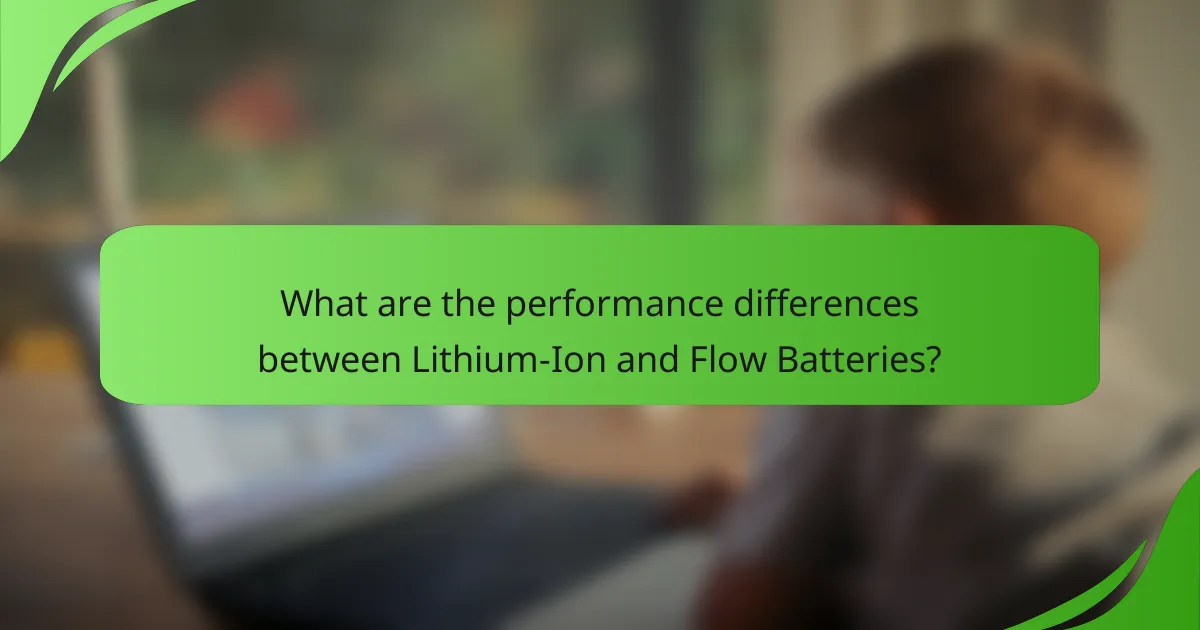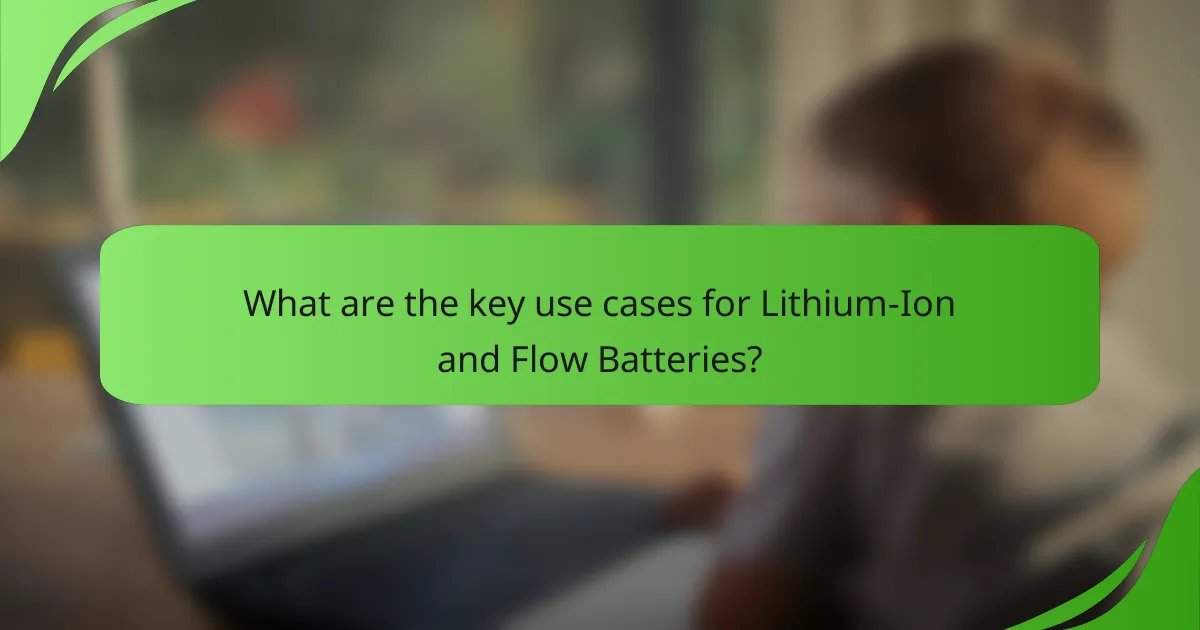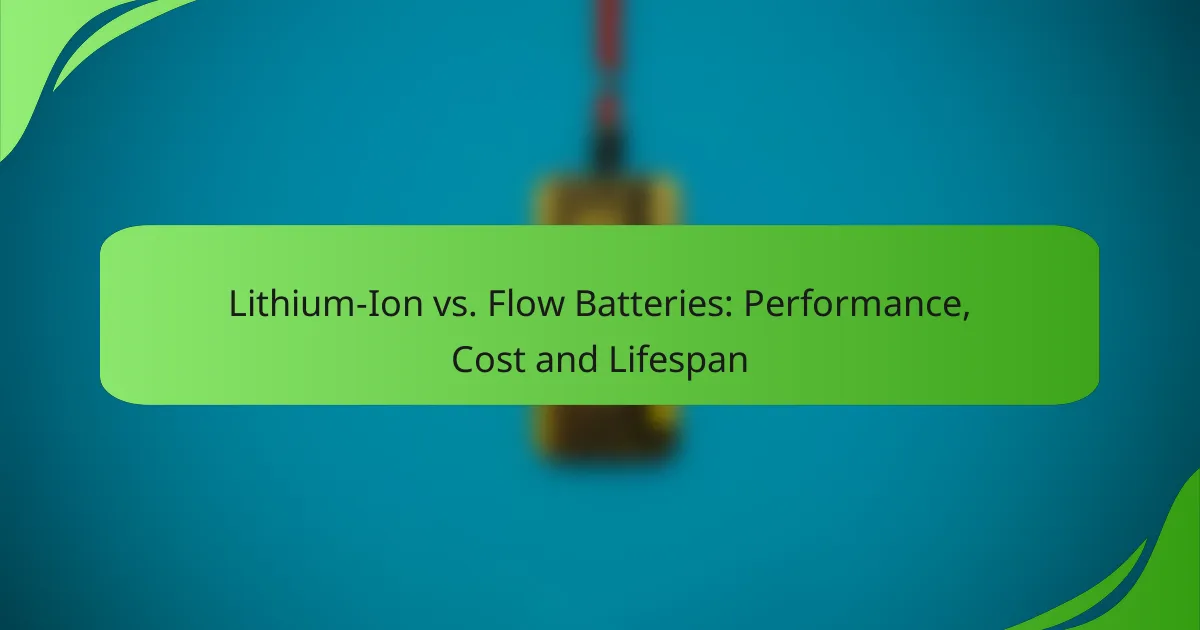Lithium-Ion and Flow Batteries present contrasting advantages in performance, cost, and lifespan, making them suitable for different applications. While Lithium-Ion batteries are known for their high energy density and lower initial costs, Flow Batteries stand out for their scalability and extended longevity, often exceeding 10,000 cycles. Understanding these differences is crucial for selecting the right battery technology for specific energy storage needs.

What are the performance differences between Lithium-Ion and Flow Batteries?
Lithium-Ion and Flow Batteries differ significantly in performance, affecting their suitability for various applications. Lithium-Ion batteries generally offer higher energy density, while Flow Batteries excel in scalability and longevity.
Lithium-Ion energy density
Lithium-Ion batteries are known for their high energy density, typically ranging from 150 to 250 Wh/kg. This makes them ideal for applications where space and weight are critical, such as in electric vehicles and portable electronics.
The compact design allows for more energy storage in a smaller footprint, which is a significant advantage in consumer electronics. However, this high energy density comes with trade-offs in terms of lifespan and thermal management.
Flow Battery scalability
Flow Batteries offer superior scalability compared to Lithium-Ion batteries. Their design allows for easy adjustment of capacity by simply increasing the size of the storage tanks, making them suitable for large-scale energy storage solutions.
This scalability is particularly beneficial for renewable energy applications, where energy storage needs can fluctuate significantly. Flow Batteries can be expanded without major redesigns, allowing for flexible deployment in grid storage or industrial applications.
Charge/discharge rates
Lithium-Ion batteries typically have faster charge and discharge rates, often completing cycles in minutes. This rapid response makes them suitable for applications requiring quick bursts of energy, such as in electric vehicles during acceleration.
In contrast, Flow Batteries usually have slower charge and discharge rates, which can range from several minutes to hours. This slower performance may limit their use in applications needing immediate power but is often sufficient for grid storage where timing is less critical.
Temperature performance
Lithium-Ion batteries perform optimally within a narrow temperature range, usually between 20°C and 25°C. Extreme temperatures can lead to reduced efficiency, capacity loss, or even safety hazards.
Flow Batteries, however, are more tolerant of temperature variations, making them suitable for diverse environments. They can operate effectively in a wider range of conditions, which is advantageous for outdoor installations or regions with fluctuating climates.
Cycle efficiency
Lithium-Ion batteries generally exhibit high cycle efficiency, often exceeding 90%. This means they can convert a significant portion of stored energy back into usable power, making them efficient for frequent cycling applications.
Flow Batteries, while also efficient, typically have lower cycle efficiencies, ranging from 70% to 85%. This difference can impact the overall cost-effectiveness of energy storage solutions, especially in scenarios requiring frequent charge and discharge cycles.

How do Lithium-Ion and Flow Batteries compare in cost?
Lithium-ion and flow batteries have distinct cost structures that affect their overall affordability and economic viability. While lithium-ion batteries typically have lower initial costs, flow batteries may offer better long-term savings due to their longevity and lower maintenance expenses.
Lithium-Ion initial investment
The initial investment for lithium-ion batteries is generally lower compared to flow batteries. Prices can range from a few hundred to a couple of thousand USD per kWh, depending on capacity and technology. This makes them attractive for applications requiring quick deployment and lower upfront costs.
However, the total cost of ownership should be considered, as lithium-ion batteries may require replacement after several years, impacting long-term financial planning.
Flow Battery long-term costs
Flow batteries typically have higher upfront costs, often exceeding several thousand USD per kWh. Despite this, they excel in long-term cost efficiency due to their longer lifespan, which can reach over 20 years. This durability translates into lower replacement frequency and reduced overall expenditure over time.
Additionally, flow batteries can be scaled easily, allowing for cost-effective expansions as energy needs grow without significant additional investments.
Cost per kWh analysis
When analyzing the cost per kWh, lithium-ion batteries often show a lower initial cost but may end up being more expensive over their lifecycle due to shorter lifespan and efficiency losses. Flow batteries, while initially pricier, can provide a more favorable cost per kWh when considering their longevity and efficiency in large-scale applications.
For example, the cost per kWh for lithium-ion systems might be around $300-$700, while flow batteries can range from $500-$1,200, reflecting their different use cases and economic models.
Maintenance expenses
Maintenance expenses for lithium-ion batteries can accumulate over time, especially as they age and require more frequent monitoring and potential replacements. Users should budget for these costs, which can vary widely based on usage and environmental conditions.
In contrast, flow batteries generally incur lower maintenance costs due to their simpler design and the ability to replace individual components without replacing the entire system. This can lead to significant savings in the long run.
Government incentives
Government incentives can play a crucial role in offsetting costs for both lithium-ion and flow batteries. Many countries offer tax credits, rebates, or grants to encourage the adoption of energy storage technologies, which can significantly reduce initial investments.
It’s essential to research local and national programs to maximize financial benefits. For instance, in the United States, the Investment Tax Credit (ITC) can provide substantial savings for battery installations, making them more accessible for consumers and businesses alike.

What is the lifespan of Lithium-Ion vs. Flow Batteries?
The lifespan of Lithium-Ion batteries typically ranges from 2,000 to 5,000 cycles, while Flow batteries can last significantly longer, often exceeding 10,000 cycles. This difference in longevity impacts their overall cost-effectiveness and suitability for various applications.
Lithium-Ion cycle life
Lithium-Ion batteries generally have a cycle life of about 500 to 1,500 full charge-discharge cycles, depending on the specific chemistry and usage conditions. Factors such as temperature, charge rates, and depth of discharge can influence their performance and longevity.
For example, operating a Lithium-Ion battery at high temperatures or frequently discharging it to very low levels can reduce its cycle life significantly. Regular maintenance and optimal charging practices can help extend its usable life.
Flow Battery longevity
Flow batteries are designed for long-term use, often achieving lifespans of 10,000 cycles or more. Their unique design allows for easy replacement of electrolyte solutions, which can help maintain performance over time.
These batteries are particularly well-suited for applications requiring frequent cycling and long-duration energy storage, such as renewable energy integration and grid stabilization. Their longevity makes them a compelling choice for large-scale energy storage projects.
Factors affecting lifespan
Additionally, the quality of materials used in battery construction and the specific design of the battery system can also play a significant role in determining overall lifespan. Regular monitoring and maintenance are essential for maximizing battery longevity.
Degradation rates
Degradation rates for Lithium-Ion batteries can vary widely, typically ranging from 5% to 20% capacity loss per year, depending on usage patterns and environmental factors. This loss can lead to reduced efficiency and shorter overall lifespan.
Flow batteries, on the other hand, experience much lower degradation rates, often less than 5% per year. Their ability to maintain performance over extended periods makes them an attractive option for long-term energy storage solutions.
Warranty comparisons
Warranties for Lithium-Ion batteries usually cover 2 to 5 years or a specific number of cycles, often around 1,000 to 2,000 cycles. This warranty period reflects the expected lifespan and performance under normal usage conditions.
Flow batteries typically come with longer warranties, often ranging from 10 to 20 years, reflecting their extended cycle life and durability. This longer warranty can provide additional assurance for users investing in large-scale energy storage systems.

What are the key use cases for Lithium-Ion and Flow Batteries?
Lithium-ion and flow batteries serve distinct purposes based on their performance characteristics, cost, and lifespan. Lithium-ion batteries excel in applications requiring high energy density and compact size, while flow batteries are preferred for large-scale energy storage and longer discharge durations.
Electric vehicles
Lithium-ion batteries are the dominant choice for electric vehicles (EVs) due to their high energy density and lightweight design. They typically provide a range of 150 to 400 kilometers on a single charge, making them suitable for daily commutes and longer trips.
Flow batteries, while not commonly used in EVs, offer advantages in specific applications like fleet vehicles that require extended operational times and quick refueling capabilities. However, their lower energy density makes them less practical for standard consumer vehicles.
Grid storage applications
Flow batteries are increasingly utilized in grid storage applications due to their ability to store large amounts of energy for extended periods. They can discharge energy over several hours, making them ideal for balancing supply and demand on the grid.
In contrast, lithium-ion batteries are often used for short-term energy storage solutions, such as frequency regulation and peak shaving. Their rapid response times are beneficial for stabilizing the grid, but they may not be as effective for long-duration storage needs.
Renewable energy integration
Both lithium-ion and flow batteries play critical roles in integrating renewable energy sources like solar and wind into the grid. Lithium-ion batteries can quickly store excess energy generated during peak production times, providing immediate power when demand spikes.
Flow batteries, however, excel in applications requiring longer discharge times, making them suitable for storing energy from renewables over days or weeks. This capability is essential for managing the intermittency of renewable energy sources.
Consumer electronics
Lithium-ion batteries are the standard in consumer electronics, powering devices such as smartphones, laptops, and tablets. Their compact size and high energy density allow for longer usage times without increasing device weight.
Flow batteries are not typically used in consumer electronics due to their larger size and complexity. They are better suited for industrial applications where their unique advantages can be fully leveraged, such as in large-scale energy systems.
